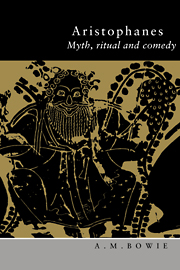Summary
So ends our tour d'horizon of what the structural study of Greek myths and rituals can tell us about the interpretation of Aristophanic comedy. A number of points may be briefly highlighted. The most crucial perhaps is the importance of not trying to impose or deduce a single structure for the reading of these plays, either individually or as a group. Although there may be certain broad structures, such as initiation or men/women, which can be detected in a number of plays, on closer inspection each play is different from the others, and will itself admit of discussion in terms of a number of different structures: I have not exhausted the possibilities here.
We have seen how, though the titles or details of the play may more or less explicitly invite discussion in terms of certain mythical or ritual structures, as in the case of Thesmophoriazusae, the Mysteries in Frogs or the reference to the ‘Lemnian fire’ in Lysistrata, attention must also be paid to structures not so indicated by the play, but identifiable by the critic from consideration of other aspects of Greek culture, as, say, the ephebeia in Wasps or divine ‘returns’ in Peace. The plays share features with other cultural constructs, and they throw mutual light upon each other even where there is no overt gesture from one to the other.
- Type
- Chapter
- Information
- AristophanesMyth, Ritual and Comedy, pp. 292 - 293Publisher: Cambridge University PressPrint publication year: 1993



